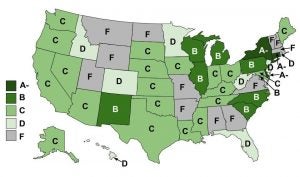Report: Grading the nation on lead pipe disclosure policies
Lindsay McCormick is a Project Manager.
When purchasing a home, buyers expect to be informed about deficiencies, defects, or environmental hazards on the property. Since 1996, there have been federal policies to alert buyers about lead in paint. However, the likelihood that a buyer will be told their prospective home has lead pipes, including a lead service line, depends on the state in which they live.
Lead service lines (LSLs) – the lead pipes connecting water mains under the street to homes and other buildings – are the primary source of lead in drinking water. Up to 10 million homes across the nation continue to receive water through LSLs, putting millions at risk of lead exposure. Homebuyers deserve to know about this liability when they choose a home and negotiate a price. When done properly, removing the full LSL significantly reduces the risk of lead exposure.
Environmental Defense Fund (EDF) analyzed and graded the housing disclosure policies of all U.S. states and the District of Columbia according to their ability to help homebuyers make informed decisions about LSLs before they sign a sales contract by assessing state disclosure laws, required disclosure forms, and voluntary disclosure forms. We did not address the extent to which LSLs are actively being disclosed under each policy.
What did we find?
We found a remarkable amount of variance in state disclosure laws – from states that require sellers to fill out detailed disclosure forms to “buyer beware” states, where the responsibility is on the buyer, not the owner, to investigate hazards.
The highest grade we gave was an A- to reflect the fact that even the top perfo rming states have room for improvement. States with mandatory disclosure that specifically asks about the presence of lead pipes received an A-. All other states were compared to these top performers.
rming states have room for improvement. States with mandatory disclosure that specifically asks about the presence of lead pipes received an A-. All other states were compared to these top performers.
- A-: Three states
- B: Seven states and Washington, DC
- C: 20 states
- D: 8 states
- F: 12 states
Conclusions
Our findings support the need for greater transparency in real estate transactions regarding LSLs. If a potential homebuyer learns of an LSL on the property before they sign a contract, they have the option to decide to add the cost of replacement to the mortgage, deduct the estimated cost from the sale price, demand replacement prior to purchase, or plan to replace it later. Over time, we anticipate that increased transparency will increase market incentives to replace LSLs.
EDF sees significant opportunities for states to help protect homebuyers from lead by improving their disclosure requirements. Short of changing state law, however, states or real estate associations could update the voluntary forms for use in real estate transactions. Water utilities can help this effort by directly informing all property owners if they are likely to have an LSL or indirectly through online mapping tools that disclose locations of LSLs in the service area, such as those developed by DC Water and Greater Cincinnati Water Works. This would create a responsibility for the property owner to disclose what is known about the service line when selling their home in states with an A- grade. Home inspectors can also help homebuyers by checking the service line as it comes into the home and letting the buyer know whether or not it is lead and recommending replacement.












